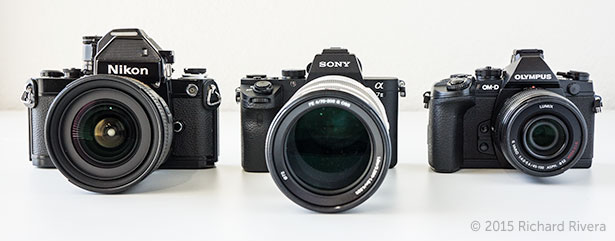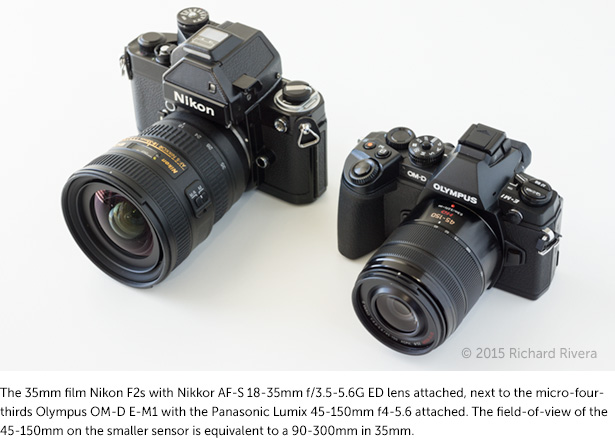
Your feedback and comments are appreciated. See Contact page for e-mails.

Are Mirrorless Cameras Always Smaller than DSLRs?
by Richard Rivera
Hype aside, this question is something that I have encountered before with photographers asking for recommendations on cameras due to the fact that I have used a few mirrorless cameras from different manufacturers since 2009. I do not believe that photographers choose a camera on the basis of one factor alone. Admittedly, depending on your shooting style, weight is important but so are other factors such as image quality, handling, sensor size, manufacturer’s lens array, optical quality of lenses, autofocus speed, etc., and depending on your priorities, weight may be the one that matters most.
When people mention size they are usually speaking about the entire package, camera and lens. Practically speaking, large sensors generally mean larger lenses. Smaller sensors generally means that smaller lenses can be designed for those specific parameters. With that as a given, you are not going to see a drastic difference between lenses of equal apertures (or focal length) designed for a full-frame mirrorless Sony and a full-frame Nikon DSLR, even though the Sony body is lighter and smaller. You will see a drastic difference between lenses for a full-frame Nikon DSLR and the Micro-Four-Thirds format Olympus OM-D E-M1, but that is comparing apples-to-oranges because of the drastic difference in sensor size. Micro-Four-Thirds sensors (aka, Four-Thirds sensors) are 1/4 the image area of full-frame sensors.
By the way, given the parameters of design for Micro-Four-Thirds sensor, Olympus and Panasonic have done an outstanding job. The intent of creating the Four Thirds sensor (same sensor used in Micro-Four-Thirds format), was to design a wholly digital standard interchangeable lens system for digital cameras that would increase mobility through size reduction. The Micro-Four-Thirds format however, further modified the Four Thirds model by entirely removing the mirror-assembly of the DSLR (digital single-lens-reflex) system and replacing the heavy pentaprism optical viewfinder with an electronic continuous Live View system, one that could function with or without an electronic viewfinder (EVF). Hence, the initial offerings in the Micro-Four-Thirds format in 2008 were the Panasonic G-1, which sported a built-in EVF; and the Olympus PEN E-P1 which did not have an EVF.
But I think the answer to the question, “Are mirrorless cameras necessarily smaller merely because they ARE mirrorless?” The answer is, “No.” It all depends on sensor size. To a large degree, sensor size determines lens size and weight.
August 18, 2015
Your feedback and comments are appreciated. See Contact page for e-mail.




Copyright © 2015 Richard Rivera & Rivera Arts Enterprises All rights reserved. No copying or reproduction of any kind without express written permission from Richard Rivera
Legal Disclosure Camera Sense and Eagles of New York are trademarks of Elk Partners LLC